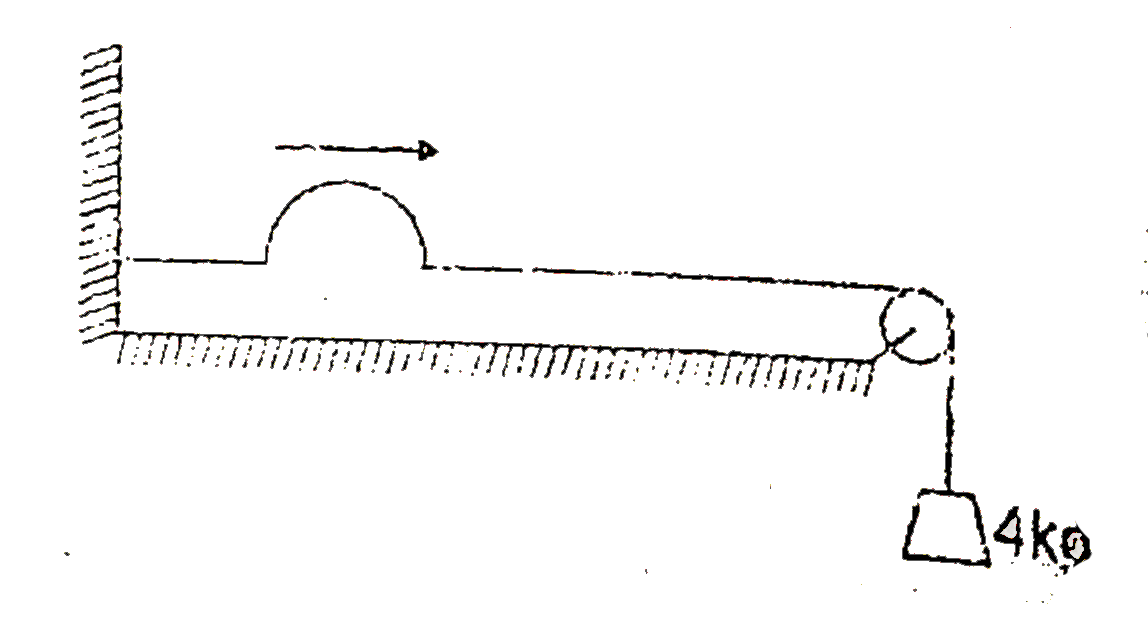Figure showa a string of linear mass density g=10 ms^-2.

The tension in the string is The wave velocity is therefoe . The time taken by the pulse in travellling through 50 cm is therefore 0.05s.
Topper's Solved these Questions
- WAVE MOTION AND WAVES ON A STRINGBOOK - HC VERMACHAPTER - WAVE MOTION AND WAVES ON A STRINGEXERCISE - Worked Out Examples
10 Videos
- WAVE MOTION AND WAVES ON A STRINGBOOK - HC VERMACHAPTER - WAVE MOTION AND WAVES ON A STRINGEXERCISE - Short Answer
7 Videos
- THE FORCESBOOK - HC VERMACHAPTER - THE FORCESEXERCISE - Exercises
12 Videos
- WORK AND ENERGYBOOK - HC VERMACHAPTER - WORK AND ENERGYEXERCISE - Exercises
64 Videos
Similar Questions
Figure shows a string of linear mass density 1.0g/cm on which a wave pulse is travelling. Find the time taken (in milli second) by the pulse in travelling through a distance of 60cm on the string. Take g=10m/s2.

View SolutionA wave pulse is travelling on a string of linear mass density 1.0gcm−1 under a tension of 1 kg wt. Calculate the time taken by the pulse to travel a distance of 50 cm on the string.Given g=10ms−2.
View Solution
Knowledge Check
Figure shows a string of linear mass density 1.0gcm−1 on which a wave pulse is travelling. Find the time taken by pulse in travelling through a distance of 50cm on the string. Take g=10ms−2
 A0.5 sB0.0005 sC0.05 sD5 s
A0.5 sB0.0005 sC0.05 sD5 s
A wave pulse is travelling on a string of linear mass density 10gcm−1 under a tension of 1kg wt. Calculate the time taken by the pulse to travel a distance of 50cm on the string. Take g=10m/s2.
View SolutionA way pulse is travelling on a string of linear mass density 6.4×10−3kgm−1 under a load of 80kgf. Calculate the time taken by the pulse to traverse the string, if its length is 0.7m.
View SolutionAn harmonic wave has been set up on a very long string which travels along the length of the string. The wave has a frequency of 50 Hz, amplitude 1 cm and wavelength 0.5 m. find
(a) the time taken by the wave to travel a distance of 8 m along the length of string (b) the time taken by a point on the string to travel a distance of 8 m, once the wave has reached the point and sets it into motion (c ) also. consider the above case when the amplitude gets doubled
View SolutionA wave pulse on a string moves a distance of 8 min 0.05 s.
Find the velocity of the pulse.
View SolutionA sinusoidal wave travels along a taut string of linear mass density 0.1g/cm. The particles oscillate along y-direction and the disturbance moves in the positive x-direction. The amplitude and frequency of oscillation are 2 mm and 50 Hz respectively. The minimum distance between two particles oscillating in the same phase is 4 m.
(a) Find the tension in the string.
(b) Find the amount of energy transferred through any point of the string in one second.
(c) If it is observed that the particle at x=2m is at y=1 mm at t=2s, and its velocity is in positive y-direction, then write the equation of this travelling wave.
View SolutionA string SQ is connected to a long heavier string at Q. Linear mass density of the heavier string is 4 times that of the string SQ. Length of SQ is 9.5cm. Both the strings are subjected to same tension. A 50Hz source connected at S produces transverse disturbance in the string. Wavelength of the wave in string SQ is observed to be 1cm. If the source is put on at time t=0, calculate the smallest time (t) at which we can find a particle in the heavier string that oscillates in phase with the source at S.

View SolutionA 4.0 kg block is suspended from the ceiling of an elevator through a string having a linear mass desity of 19.2×10−3kgm−1. Find the speed (with respect to the string) with which a wave pulse can proceed on the string if the elavator accelerates up at the rate of 2.0ms−2.Takeg=10ms−2.
View Solution
